You may want to start by speaking with your dentist.
He or she can tell you whether whitening procedures would be effective
for you. Whiteners may not correct all types of discoloration. For
example:
- yellowish hued teeth will probably bleach
well
- brownish-colored teeth may bleach less well, and
- grayish-hued teeth may
not bleach well at all.
Likewise, bleaching may not enhance your smile
if you have had bonding or tooth-colored fillings placed in your front
teeth. The whitener will not effect the color of these materials, and
they will stand out in your newly whitened smile. In these cases, you
may want to investigate other options, like porcelain veneers or dental
bonding.
You also may want to speak with your dentist should
any side effects become bothersome. For example, teeth can become
sensitive during the period when you are using the bleaching solution.
In many cases, this sensitivity is temporary and should lessen once the
treatment is finished. Some people also experience soft tissue
irritation—either from a tray that doesn’t fit properly or from
solution that may come in contact with the tissues. If you have concerns
about such side effects, you may want to discuss them with your dentist.
We have two different methods of whitening your
teeth:
- In-office whitening
is a way to jump start the whitening procedure. By using a strong
concentration of the whitening gel, the teeth get bleached quickly.
- Home whitening
is used to complete the bleaching procedure and keep your teeth looking
white for years.
Before Bleaching
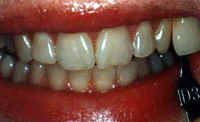
Before Whitening, the teeth appear dark, and discolored. The
shade tab shows the original color of the teeth. |
After Bleaching
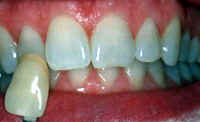
After approximately 7 days of home whitening, a dramatic
difference can be seen in the teeth. Note the change in color by
comparing the teeth to the shade tab. |
|
Before After After

This is an example of some teeth that were stained due to ageing. |
|
In-office
whitening
The quickest way to whiten your teeth
|
"in-office" method where a strong
bleaching agent is placed over the isolated teeth and a special light is used to
assist the bleaching material lighten the teeth.
The procedure outlined below takes about 45
minutes to 1 hour to complete and whitens your teeth up to 7 shades lighter.
This method is generally more controlled and
probably better for people who have tetracycline stains or streaks on their
teeth.
The advantage of in-office treatment is that
bleaching trays do not need to be worn for an extensive period to obtain whiter
teeth. In fact when you leave our office you will have significantly whiter
teeth.
The disadvantage of the in-office whitening treatment is
the inability to control the amount of whiteness. Also once you have your teeth
whitened, the inability to touch up and maintain white teeth is more difficult.
The most common methods used are the
The "home" techniques involve
making trays which fit into the mouth and these are then filled with bleaching
materials. When worn for a few hours a day, noticeable results are seen
generally within a few days to a couple weeks.
|
Home whitening
A predictable way to keep teeth
whiter
|
At home whitening is an ideal way
to make sure that your teeth stay white after you have beached them. Used
either by itself or in conjunction with in-office bleaching, it is a
simple and inexpensive method to bleach your teeth.
Custom made trays made in our office especially for your teeth are filled
with the bleaching gel. The trays are worn for up to two hours a day for 7
to 10 days with the bleaching gel inside. |
Loading The Tray
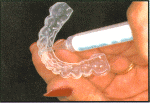
|
By keeping the bleaching gel in contact with
your teeth for the prescribed period of time, your teeth get whiter.
Another advantage of at-home whitening is
that twice a year you can do a touch up treatment with your trays and the
extra bleach our office supplies for you. That way you can maintain your
white teeth forever.
Although the time required for the treatment
is longer than in-office whitening, the results are usually far superior.
Because of this at our office we combine the two treatments. In-office
whitening for the fastest results and at-home whitening to maintain your
teeth.
Bleaching solutions. Many
of these products contain peroxide(s), which actually bleach the
surfaces of the teeth. These products typically rely on 10
percent carbamide peroxide (which is equivalent to 3 percent hydrogen
peroxide). In the last decade, carbamide peroxide has been demonstrated
as a safe and effective whitening agent when used as directed.
Peroxide-containing whiteners typically come in a gel and are placed in
a mouthguard, which you wear for about two hours a day over about two
weeks.
Results vary from individual to individual and
it is probably best to check with your dentist to help decide which method works
best for you. Some of the factors involved include the intensity of the stains,
whether or not you have fillings or crowns on your front teeth as well as what
may have caused the stains.
Bleaching of the teeth is a very
popular procedure that is being requested
by a large number of our patients.The most cost effective approach is with
the use of the "take home" bleaching mouthpieces.The before and after
images
shown below. The results are very evident and common with all of our patients. I
have been very careful to correctly reproduce the color accurately in both images.
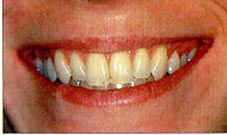
Before |
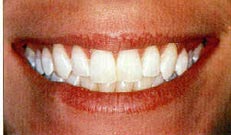
After |
![]()